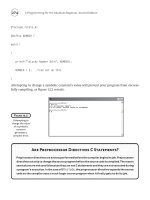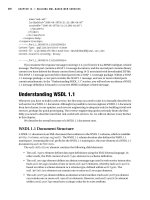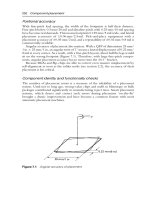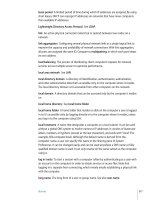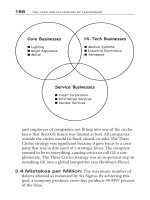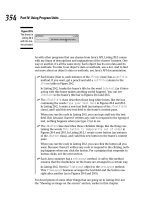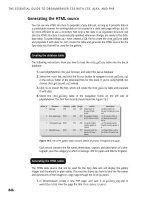THE VEST POCKETGUIDE TOINFORMATION TECHNOLOGY 2nd phần 10 ppt
Bạn đang xem bản rút gọn của tài liệu. Xem và tải ngay bản đầy đủ của tài liệu tại đây (769.46 KB, 33 trang )
325
Integrates with ERP
Yes
Yes
Yes
Yes (Risk Na vigator) ; No
(Focus)
XBRL enabled
Yes
No
Yes
No (bo th)
Monitor operational
systems
Yes
Yes
Yes
No (bo th)
Size of business targeted
All
L
M, SMB, L
S (Focus), M (both), L (Risk
Navigator)
Price
$65,000 and up (minimum
25 users)
$125,000 (must also have
core product suite, which
starts at $100K for first 100
users)
Price available online See footnote
1
1
Risk Navigator installation package: $150,00
0, plus annual user fees (based on number of
users) starting at $150 per user.
Focus: Per-user license fees start at $700
per user, plus 20 percent maintenance charge
.
OpenPages
Open Text
Oracle
Paisley Consulting
bapp01.fm Page 325 Tuesday, July 19, 2005 5:54 PM
326
PeopleSoft
Providus Software
Solutions
SAP
SAS
$1.9 billion revenues
Founded 1987
Under $5 million revenues
Founded 2002
$9.5 billion revenues
Founded 1972
$1.2 billion revenues
Founded 1976
Sarbox/404 program
PeopleSoft Enterprises
Internal Controls Enforcer
RiskResolve 3.0 for
Sarbanes-Oxley for
financial services industry
SAP Compliance
Management for
Sarbanes-Oxley Act
SAS Corporate
Compliance for Sarbanes-
Oxley (v. 2.1)
Program description
Designed to automate
and enforce internal
controls required under
404. Enables users to
streamline documentation
and continuously monitor
internal controls.
Diagnostic capabilitites
intended to help
companies reduce the
cost of compliance.
Software provides
financial institutions with
single Active Risk
Management Console,
enabling a top-down view
of risk and potential risk
across all lines of business.
Addresses internal-control
requirements of 404 via
comprehensive
management of rols.
Helps document/model
business processes,
document existing
controls, test results, and
suggest improvements.
Also provides status
reports to management
according to law’s
provisions.
Targets all relevant Sarbox
provisions. Software
provides tracking and
auditing of internal
controls, rapid
consolidation of financial
data, validation/
verification of financial
reports, and dashboard
monitoring, as well as risk-
impact assessment and
alerts.
Financial controls
documentation
Yes
Yes
Yes
Yes
Financial controls
attestation
Yes
Yes
Yes
Yes
bapp01.fm Page 326 Tuesday, July 19, 2005 5:54 PM
327
Integrates with ERP
Yes
Yes
Yes
Yes
XBRL enabled
No
No
Yes
No
Monitor operational
systems
Yes
No
Yes
Yes
Size of business targeted
SMB, L
All
All
All
Price
Varies
Varies, ranging from
$120,000 to $350,000 and
up for large-scale
enterprisewide
deployments
Contact vendor
Base price for software
license, plus per-user cost
Source: From CFO.com © CFO Publishing C
orporation 2004. All rights reserved. Reprinted
by permission.
PeopleSoft
Providus Software
Solutions
SAP
SAS
bapp01.fm Page 327 Tuesday, July 19, 2005 5:54 PM
328
A
PPENDIX
B
CRM S
OFTWARE
P
ROVIDERS
bapp02.fm Page 328 Tuesday, July 19, 2005 5:51 PM
329
Provider
ACCPAC
Pleasanton, CA
(800) 945-8007
Aspect
Communications
San Jose, CA
(800) 391-2341
Baan
Golden, CO
(800) 967-6730
Best Software (CRM
division
)
Scottsdale, AZ
(800) 643-6400
Blue Martini
Software
San Mateo, CA
(800) 258-3627
Sales/Marketing
Contact
ACCPAC Client Care
(800) 873-7282
Lakshmi Bakshi
(408) 325-2623
Lailla Matthews
(303) 274-3112
Bob Neeser
(800) 643-6400
Laurent Pacalin
(650) 356-4000
Product Name ACCPAC CRM
Aspect Enterprise
Contact Server
iBaan for CRM
SalesLogix
Blue Martini 4
Provider
BroadVision
Redwood City, CA
(866) 287-6669
Chordiant Software
Cupertino, CA
(888) 246-7342
Computer Associates
International
Islandia, NY
(800) 225-5224
Dendrite
Morristown, NJ (973)
425-1200
E.piphany
San
Mateo, CA
(877) 764-4163
Sales/Marketing
Contact
Stephanie Mello
(214) 224-5969
Jonathan Miller
(888) 246-7342
Robert Sterbens (631)
342-3307
Mark Maffei
(908) 541-5877
Mike Trigg
(650) 356-3800
Product Name BroadVision One-to
-One
Enterprise
Chordiant 5 Selling
and Servicing
Intelligent CRM Suite WebForce
E.piphany E.5
Provider
eGain Communications
Sunnyvale, CA
(888) 603-4246
Firepond
Waltham, MA
(800) 396-0663
FrontRange Solutions
Colorado Springs, CO
(800) 776-7889
Genesys
Daly City, CA
(888) 436-3797
Group 1 Software
Lanham, MD
(800) 368-5806
Sales/Marketing
Contact
Max Fiszer
(408) 212-3400
Eric Snow
(781) 487-8400
Michele Reser
(719) 278-7102
Dana Dye
(415) 437-1100
Linda Flynn
(301) 918-0727
bapp02.fm Page 329 Tuesday, July 19, 2005 5:51 PM
330
Product Name eGain eService Ent
erprise SalesPerformer Suite,
eService Performer
Suite
GoldMine, HEAT Genesys Suite 6
Data Quality,
Marketing
Automation
Provider
Intershop
Communications
San Francisco
(877) 644-5534
eGain
Communications
Sunnyvale, CA
(888) 603-4246
Jeeves Solutions
Emeryville, CA (877)
453-3837
Kefta
San Francisco (415)
391-6881
Motive
Communications
Austin, TX
(877) 466-8483
Sales/Marketing
Contact
Jonathan Durnin (415)
844-2138
Joel Reed
(800) 727-5333
Mike Fenn
(510) 985-7930
Michael Oiknine
(415) 391-6881
Lauren Short
(415) 856-5126
Product Name eGain eService Ente
rprise SalesPerformer Suite,
eService Performer
Suite
GoldMine, HEAT Interaction
Manager, Customer
Acquisition
Optimizer, Customer
Retention Optimizer,
Customer Service
Tools
Data Quality,
Marketing
Automation
Provider
Maximizer Software
Vancouv er
(800) 804-6299
Net Perceptions
Edina, MN
(800) 466-0711
Onyx Software
Bellevue, WA
(888) 275-6699
Oracle
Redwood Shores,
CA (800) 672-2531
PeopleSoft
Pleasanton, CA
(800) 380-7638
Sales/Marketing
Contact
Gary Vollhoffer
(800) 804-6299
Terri Reden
(952) 842-5000
Robin Rees
(425) 451-8060
Mark Jarvis
(800) 672-2531
Robb Eklund
(925) 694-3000
Product Name Maximizer, Maximizer
Enterprise
NetP 7.0
Onyx Enterprise
Oracle E-Business
Suite
PeopleSoft CRM
bapp02.fm Page 330 Tuesday, July 19, 2005 5:51 PM
331
Provider
Rainmaker Systems
Scotts Valley, CA
(800) 631-1545
Remedy
Mountain View, CA
(650) 903-5200
Responsys
Palo Alto, CA
(888) 219-7150
SafeHarbor
Technology
Seattle
(800) 480-5777
Salesforce.com
San Francisco
(800) 667-6389
Sales/Marketing
Contact
Kerry Benoit
(831) 430-3800
Steve Balentine
(650) 919-5717
Mike Romley
(650) 858-7434
Sue Cummings
(206) 922-5003
(800) 667-6389
Product Name Contract Rene
wals Plus Remedy CRM
Responsys Interact SafeHarbor Suppo
rt
Services 3.0, Online
Banking Support
Services 3.0
CRM
Provider
SAP America
Newtown
Square, PA
(800) 872-1727
eGain
Communications
Sunnyvale, CA
(888) 603-4246
SAS
Cary, NC
(800) 727-0025
Sento
American Fork, UT
(801) 492-2000
Siebel Systems
San Mateo, CA
(800) 647-4300
Sales/Marketing
Contact
(610) 661-1000
Joe Springer (408)
558-4847
Customer Interaction
Center (800) 727-0025
Jason Young
(801) 492-2000
Thomas Arnold
(510) 788-4518
Product Name mySAP CRM
iAvenue
The SAS Analytical
CRM Solution
Customer Choice
Platform, Assist,
Recite, Service
Portal
Siebel eBusiness
Applications V.7
Source: CFO.com© CFO Publishing Corpora
tion 2004. All rights reserved. Reprinted by per
mission.
bapp02.fm Page 331 Tuesday, July 19, 2005 5:51 PM
332
G
LOSSARY
802.11 a family of specifications developed by the U.S. Insti-
tute of Electrical and Electronics Engineers (IEEE). There are
currently three specifications in the family (802.11a, 802.11b,
and 802.11g), with more being developed. The 802.11b stan-
dard, often referred to as Wi-Fi, is currently more wide-
spread. However, hardware manufacturers are increasingly
offering multistandard equipment that can work with vari-
ous standards.
application program computer software written specifically
to process data in an information system. It performs tasks
and solves problems applicable to a manager’s work.
artificial intelligence (AI) thinking and reasoning software
based on information input into it by a human expert. The
reasoning process involves self-correction. Significant data is
evaluated and relevant relationships uncovered. The com-
puter learns which kind of answers are reasonable and
which are not. Artificial intelligence performs complicated
strategies that determine the best or worst way to accom-
plish a task or avoid an undesirable result. Examples of
applications of AI are tax planning and capital budgeting
analysis.
audit software computer programs designed to examine
and test a company’s accounting records. Some packages aid
in gathering evidence, performing analytical tests, sampling
data, appraising internal control, audit scheduling, and
printing exception reports. The software is used by internal
auditors.
automatic programming process of using one program to
prepare another program.
automatic recovery program program enabling a system to
continue functioning even though equipment has failed.
background processing lower-priority programs are exe-
cuted when the system is not being used by higher-priority
programs.
balanced scorecard approach using multiple measures to
evaluate managerial performance. These measures may be
bgloss.fm Page 332 Thursday, August 4, 2005 5:11 PM
Glossary 333
financial or nonfinancial, internal or external, and short term
or long term. The scorecard allows a determination as to
whether a manager is achieving certain objectives at the
expense of others that may be equally or more important.
There are four different perspectives: (1) financial, (2) cus-
tomer, (3) process, and (4) the learning and growth.
baud serial information transfer speed with which a modem
receives and sends data.
block diagram diagram using symbols to explain the inter-
connections and information flow between hardware and
software.
budgeting models computer-based mathematical models
generating all kinds of corporate budgets (e.g., cash flow, prof-
itability). The models help managers look at a variety of what-
if questions. The resultant calculations provide a basis for
choice among alternatives under conditions of uncertainty.
buffer area of a computer’s memory set aside to hold infor-
mation temporarily.
business intelligence a business strategy that integrates and
analyzes operational data from an array of internal sources
to improve decision making and competitiveness.
business performance management (BPM) the use of busi-
ness intelligence-derived operational metrics, ranging from
ad hoc yardsticks to Six Sigma or balanced scorecard, to mea-
sure company performance.
business process reengineering (BPR) approach aiming at
making revolutionary changes as opposed to evolutionary
changes by eliminating nonvalue-added steps in a business
process and computerizing the remaining steps to achieve
desired outcomes.
catalog directory of locations of files.
chain links series of linked data items.
corporate planning model computer-based integrated busi-
ness planning model in which production and marketing
models are linked to the financial model. It is a description,
explanation, and interrelation of functional areas of a busi-
ness (accounting, finance and investments, marketing, pro-
duction, management, economics) expressed in terms of
mathematical and logical equations so as to generate a vari-
ety of reports including financial forecasts. Corporate plan-
ning models may also be used for risk analysis and what-if
experimentation. The goals of the model include improving
the quality of planning and decision making, reducing the
decision risk, and favorably influencing the future corporate
environment.
bgloss.fm Page 333 Thursday, August 4, 2005 5:11 PM
334 Glossary
customer relationship management (CRM) software. soft-
ware that automates customer service and support. It also
provides for customer data analysis and supports e-commerce
storefronts.
cyber investing investing through telecommunications, such
as online trading on the Internet.
cyberspace originally used in Neuromancer, William Gibson’s
novel of direct brain-computer networking, refers to the col-
lective realms of computer-aided communication.
data interchange format (DIF) file system to transfer com-
puter files from one program to another.
data warehouse a database structured to tactical information
that can be used to answer specific questions about transac-
tional company history.
database management software computer programs used to
manage data in a database. It is a set of programs that pro-
vide for defining, controlling, and accessing the database.
The software allows managers to enter, manipulate, retrieve,
display, select, sort, edit, and index data.
debug process of tracing and correcting flaws in a software
program or hardware device. Computerized routines may be
used to find bugs.
decision support system (DSS) branch of a management
information system that provides answers to management
problems and that integrates the decision maker into the sys-
tem as a component. DSS software provides support to the
manager in the decision-making process. It analyzes a spe-
cific situation and can be modified as the manager desires.
Examples of applications include planning and forecasting.
enterprise resource planning (ERP) software system that
grew out of material requirements planning (MRP) systems
to computerize inventory control and production planning.
Key features include an ability to prepare a master produc-
tion schedule, a bill of materials, and purchase orders.
expert systems computer software involving stored reason-
ing schemes and containing decision-making processes of
business experts in their specialized areas. The software
mimics the way human experts make decisions. The expert
system appraises and solves business problems requiring
human intelligence and imagination that involve known and
unknown information. The components of the expert system
include a knowledge base, inference engine, user interface,
and knowledge acquisition facility.
Extensible Business Reporting Language (XBRL) formerly
code named XFRML, a freely available electronic language
bgloss.fm Page 334 Thursday, August 4, 2005 5:11 PM
Glossary 335
for financial reporting. It is an XML-based framework that
provides the financial community with a standards-based
method to prepare, publish in a variety of formats, reliably
extract, and automatically exchange financial statements of
publicly held companies and the information they contain.
file server computer providing access to files for remote
users.
financial analysis software software capable of taking finan-
cial data (e.g., online information on the World Wide Web)
and performing trend and ratio calculations. Investment and
credit decisions are based on the analysis results.
financial model a functional branch of a general corporate
planning model. It is essentially used to generate pro forma
financial statements and financial ratios. A financial model is
a mathematical model describing the interrelationships
among financial variables of the firm. It is the basic tool for
budgeting and budget planning. Also, it is used for risk anal-
ysis and what-if experiments. Many financial models of
today are built using special modeling languages such as
IFPS or spreadsheet programs such as Excel.
gateway application specific node that connects incompati-
ble networks.
gopher browser and searching program for the Internet.
graphic software program showing business information in
graphic form, including charts and diagrams. This enhances
the understanding of the information in terms of trends and
relationships.
hotspot provides high-speed wireless Internet access in con-
venient public locations or at home. Using either a laptop or
PDA that is 802.11 wirelessly enabled, people can download
their e-mail attachments, watch a live Webcast, or listen to
streaming audio.
hyperlink a connection between different information
sources.
hypertext database approach linking related data, programs,
and pictures.
integrated software software package that combines many
applications in one program. Integrated packages can move
data among several programs utilizing common commands
and file structures. An integrated package is recommended
when identical source information is used for varying mana-
gerial purposes and activities.
intelligent agents personal assistant software enabling a
manager to work more efficiently and productively, reduce
bgloss.fm Page 335 Thursday, August 4, 2005 5:11 PM
336 Glossary
costs, and save time. The software learns from instruction,
examples, and practices. Intelligent agents can interact with
each other. A workstation management agent conducts desk-
top activities such as reviewing and replying to e-mail mes-
sages, managing schedules and calendars, and making notes
from meetings. A task coordinator agent simplifies and orga-
nizes complicated functions. It aids in planning, coordinat-
ing, and managing resources. A teacher/peer agent explains
complex information. An information overhead agent han-
dles users’ problems and answers questions.
interface means of interaction between two computer
devices or systems that handle data (e.g., formats, codes) dif-
ferently. An interface is a device that converts signals from
one device into signals that the other device needs.
Internet international network connecting smaller networks
linking computers of different entities.
Intranet internal company Web sites. It is developed by the
company itself.
knowledgement managenent a broad strategic approach to
identifying and using a company’s knowledge to improve its
efficiency. One subset of knowledge, structured data, can be
managed using business intelligence tools.
local area network (LAN) linking of computers and other
devices for intersite and intercompany applications in a
small geographic area.
management information system (MIS) a computer-based
or manual system that transforms data into information use-
ful in the support of decision making.
material requirements planning (MRP) computerized data
processing system whose function is to schedule production
and control the level of inventory for components with
dependent demand.
multitasking simultaneous execution of two or more com-
puter functions.
network (1) interconnected nodes (points) where working
units interreact (link) with others. (2) connection of comput-
ers and devices.
neural networks a technology in which computers actually
try to learn from the database and operator what the right
answer is to a question. The system gets positive or negative
response to output from the operator and stores that data so
that it will make a better decision the next time. While still in
its infancy, this technology shows promise for use in fraud
bgloss.fm Page 336 Thursday, August 4, 2005 5:11 PM
Glossary 337
detection, accounting, economic forecasting, and risk
appraisals.
online analytical processing (OLAP) powerful tools that
take a complex, multidimensional view of aggregated data
to quickly yield strategic information. The power of OLAP
tools is predictive in answering why? and what-if questions.
online searching using a computer retrieval system to
obtain information from a database such as on the Internet.
optical character recognition computer tool that recognizes
typed or printed characters on paper so that they can be
recorded on disk.
real time computer processing of data in connection with
another process outside the computer.
relational database a database consisting of relationships
between data items.
simulation an attempt to represent a real-life system via a
model to determine how a change in one or more variables
affects the rest of the system, also called what-if analysis.
speech recognition software program in which verbal com-
mands activate the computer to perform functions.
spreadsheet table of numbers arranged in rows and columns
to make accounting, finance, marketing, and other business
calculations. Spreadsheets facilitate end-result summary
numbers, what-if experimentations, and projections.
statistical software computer program making quantitative
calculations such as standard deviation, coefficient of varia-
tion, regression analysis, correlation, and variance analysis.
structured data subset of a company’s data that is stored elec-
tronically in databases and thus can be accessed by data field.
supply-chain management management of the integration
of the functions, information, and materials that flow across
multiple firms in a supply chain—i.e., buying materials,
transforming materials, and shipping to customers.
tag a command inserted in a document that specifies how
the document or a portion of the document should be for-
matted. Tags are used by all format specifications that store
documents as text files. This HTML.
tax software tax modules preparing federal and state income
tax returns. Tax planning modules exist to examine tax
options and alternatives to minimize the company’s tax lia-
bility in current and future years. What-if tax situation sce-
narios may be evaluated.
bgloss.fm Page 337 Thursday, August 4, 2005 5:11 PM
338 Glossary
template computer-based worksheet that includes the rele-
vant formulas for a particular application but not the data. It
is a blank worksheet on which data is saved and filled in as
needed for a future business application and to solve prob-
lems. Templates are predefined files, including cell formulas
and row and column labels for specific spreadsheet applica-
tions, or style sheets and macros in word processing. Tem-
plates allow for the referencing of cells and formulations of
interrelated formulas and functions. They are reused to ana-
lyze similar transactions.
terminal input-output device allowing a user to communi-
cate directly with a computer.
thinking software computer programs used by managers to
prepare written reports, including specialized analyses of
corporate operations. The software contains aids to improve
writing skills and idea formulation so that managers can bet-
ter create an outline and written report. The information is
labeled, organized, and structured.
time software computer program that tracks hours worked
by employees by function, operation, or activity. It prepares
an analysis of the variance between budgeted and actual
hours as well as prepares trends in actual hours over a stated
time period (e.g., quarterly comparisons).
utility program program supporting the processing of a
computer such as diagnostic and tracing programs.
wide area network (WAN) network connecting sites in a
large geographic area.
Wi-Fi short for “wireless fidelity,” the popular term for a
high-frequency wireless local area network. The Wi-Fi tech-
nology is rapidly gaining acceptance in many companies as
an alternative to a wired LAN. It can also be installed for a
home network.
wireless technology a variety of technologies to communi-
cate without wires, namely radio transmissions. Examples
are cellular, microwave, infrared, and satellite.
W-LAN enables a mobile user to connect to a local area net-
work (LAN) through a wireless (radio) connection. A stan-
dard, 802.11, specifies the technologies for wireless LANs.
World Wide Web (WWW) Internet system for worldwide
hypertext linking of multimedia documents, making the
relationship of information that is common between docu-
ments easily accessible and completely independent of phys-
ical location.
XBRL see Extensible Business Reporting Language (XBRL)
bgloss.fm Page 338 Thursday, August 4, 2005 5:11 PM
Glossary 339
XML a general-purpose markup (tagging) standard for cre-
ating languages to standardize the data exchange between
different computing platforms and applications. XML uses
tags (markup) to identify pieces of data, and leaves the inter-
pretation of the data to the user, such as one who is review-
ing the financial numbers and their significance for a
database management application.
bgloss.fm Page 339 Thursday, August 4, 2005 5:11 PM
bgloss.fm Page 340 Thursday, August 4, 2005 5:11 PM
341
I
NDEX
A
Access point (AP), 267
Accounting packages, 118–119
audit software, 129–128
compliance software, 143–144
extensible business reporting language (XBRL), 136–138
software in, 119
ABC, 134–136
market leaders, 121–124
modules in, 119–121
spreadsheets, 130–131
risk management, 132–134
selection criteria, 131
tax preparation software, 126–128
market leaders, 127–128
value-chain management software, 138–143
windows interface benefits, 118–119
write-up software, 126
major products of, 126
Activity-based costing (ABC) system. See also Cost systems
software, 134–136
ALU. See Arithmetic/logic unit
America Online, 102
Application program, 49
Arithmetic/logic unit (ALU), 37–38
Artificial intelligence (AI). See also Expert systems, 224–225
Audit software, 129–130
Automatic programming, 232
B
Bankruptcy
Altman's prediction model, 159
forecast of, 158–163
Z-score model of, 159–160
Baud, 91
Bluetooth, 41, 263–265
piconet, 264
promoter members of, 271
Bridge, 95
Budgeting and planning (B&P) software
latest generation of, 178–180
Budgeting. See also Planning
Excel and, 151–158
bindex.fm Page 341 Friday, August 5, 2005 9:48 AM
342 Index
financial modeling and, 166
IFPS and, 151
software for, 172–180
Up Your Cash Flow and, 151–158
Buffer, 92
Bulletin board systems (BBSs), 90
Business intelligence, 143
Business process management (BPM), 144
C
CAD. See Computer-assisted design
CAM. See Computer-aided manufacturing
Capital budgeting, 278
CASE. See Computer-aided software engineering
Central processing unit (CPU)
and bus lines, 39
capacity of, 38
and computing power, 41
and system clock, 38
function of, 37
Common gateway interface (CGI), 115
Communication media. See also Data communications
modems, 82
wired
coaxial cable, 80
fiber optical cable, 80
TPW, 79
wireless
GPS, 82
microwave systems, 80
pagers/cellular phones, 82
satellite systems, 81–82
Compliance software, 143–144
technologies that assist, 143–144
CompuServe, 102
Computer networks, 93–95
advantages of, 94
bridge, 95
data flow in, 94–95
data switching equipment, 94
dedicated server, 95
electronic databases, 101–102
full-duplex system, 94
half-duplex transmission, 94
interfacing advantages, 100
interfacing disadvantages, 101
medium selection for, 93–94
network servers and, 37
nondedicated server, 95
simplex transmission, 94
topologies of, 95
hierarchical, 96
horizontal (bus), 96–97
mesh, 99
bindex.fm Page 342 Friday, August 5, 2005 9:48 AM
Index 343
Computer networks (continued)
ring, 98–99
star, 97–99
WANs/LANs, 100
Computer security
audit trail and, 254
communications security, 249–250
Computer Fraud and Abuse Act, 262
controls for, 250–253
environmental security and, 255
and financial loss/cost-benefit criteria, 243–244
network security and, 255–257
personnel security and, 253–254
physical security and, 244–245
fire, 247
physical access control, 245–246
sabotage, 247–249
risks, 242–243
in EDI, 253
security administrator and, 258–261
Computer systems. See also Microcomputer systems; Operating
systems
programming language processors, 51
software, 49
utility programs, 51
Computer-aided manufacturing (CAM), 191–192
Computer-aided software engineering (CASE) tools, 58
Computer-assisted design (CAD), 31, 191
Computers. See also Microcomputers
application software, 4
computing power of, 41
hardware
mainframe computers, 3
minicomputers, 3
personal computers, 2
servers, 2
supercomputers, 3
and information systems, 1–2
system software, 4
technologies for business, 8
Contribution margin (CM)
LP and, 25
optimization models and, 25
standard deviation and, 28
Cost systems. See also Profit/loss
ABC software and, 134–136
financial MISs and, 148
CPM (critical path method), 307, 311–316
Customer relationship management systems (CRM), 141–143
D
Data communications
computer conferencing, 88
digital data vs. analog data, 78
digital signals vs. analog signals, 78
bindex.fm Page 343 Friday, August 5, 2005 9:48 AM
344 Index
digital transmission vs. analog transmission, 78–79
GPS, 82
Internet, 85–87
Intranets, 87
LAN, 83–84
microwave systems, 80
modems, 82
multimedia, 88–89
applications, 88–89
network software, 87
network topologies, 84–85
pagers/cellular phones, 82
satellite systems, 81–82
WAN, 84
wired communication media, 79–80
wireless communication media, 80–82
Data mining 262
Data switching equipment, 94
Data. See also Database
dictionary, 74
digital vs. analog, 78
in MIS, 4
Database administrator (DBA)
and DBMS, 62
description of, 75–76
languages required by, 62
responsibilities of, 76
Database management software, 74
Database management system (DBMS), 6
advantages of, 68–69
data dictionary in, 74
database recovery, 75
utility programs for, 75
Database(s)
business, 101
definition of, 68–69
design of, 73–74
electronic, 101–102
faxback services, 102
files
description of, 69
direct, 70
indexed sequential, 69
sequential, 69
types of, 69–70
foreign key field, 72
hierarchical, 71
languages, 62
network, 71
object oriented, 71
primary key field, 72
relational, 70
secondary key field, 72
software, 61–62
bindex.fm Page 344 Friday, August 5, 2005 9:48 AM
Index 345
Debug, 74
Decision making, 14
decision matrix and, 29–30
decision tree and, 30–31
information needed for
corporate goals/policies, 146–147
from external sources, 147
from transaction processing system, 146
Decision making
long-term asset decisions, 171
long-term financing decisions, 171–172
management levels and, 18
MISs and, 7, 17
models, 33
short-term decisions, 170–171
Decision support systems (DSSs), 217–218
applications of, 219–221
and decision making, 6
and EIS, 216–217
and ES, 216
and MIS, 216–217
Palisades Decisiontools Suite, 218–219
and TPS, 216
Dialog, 103
Digital service line (DSL), 268
Dow Jones News Retrieval, 103
DSSs. See Decision support systems
E
EDI. See Electronic data interchange
EISs. See Executive Information Systems
Electronic commerce, 86
Electronic data interchange (EDI), 253
Electronic mail (e-mail), 85
Enterprise resource planning (ERP) systems, 12, 138–141
ES. See Expert Systems
Executive information systems (EISs)
applications of, 222–223
characteristics of, 221–222
limitations of, 222
when to use, 7
Expert systems (ES), 225
and accounting systems, 233–235
applications of, 230–232
and automatic programming, 232
benefits of, 238–239
for capital expenditures planning, 235
case-based, 227–228
components of, 225–228
for credit/loan applications analysis, 235–236
disadvantages of, 239
and fuzzy logic, 232
in global financial market, 238
and insurance, 237
bindex.fm Page 345 Friday, August 5, 2005 9:48 AM
346 Index
in marketing, 236
neural networks in, 239–241
for portfolio management, 237
rule based, 227
shells/products of, 228–229
in trading advising, 237–238
uses of, 229–230
Extensible Authentication Protocol (EAP), 267
Extensible business reporting language (XBRL), 136–138
applications of, 137–138
statement creation, 137
F
File server, 2, 83
Financial analysis
and planning, 169–170
ratio analysis, 167–168
with spreadsheets, 166
Financial management information systems, 145–146
and depreciation method, 168–169
budgeting/planning software, 172–180
financial modeling languages, 166
and forecasting financial needs, 147, 164–166
long-term asset decisions, 171
long-term financing decisions, 171–172
maximum vs. minimum profits, 168
outputs, 147
budgeting, 151
forecasting, 147
funds management, 150–151
intelligence, 148–150
planning/forecasting, 169–170
prediction models
percent of sales, 164–166
Z-score, 158–163
and ratio analysis, 167–168
short-term decisions, 170–171
subsystems
cost systems, 148
profit/loss systems, 148
Z-score model, 159–160
applications of, 160
precautions in using, 160, 163
Flexible manufacturing systems (FMSs), 194
FMSs. See Flexible manufacturing systems
ForeCalc, 212
Forecast Pro, 214
Forecast! GFX, 211
Forecasting
and marketing management, 199
bankruptcy, 158–163
financial, 147
percent-of-sales method, 164–166
and planning, 169–170
software for, 211–215
bindex.fm Page 346 Friday, August 5, 2005 9:48 AM
Index 347
Full-duplex system, 94
Fuzzy.logic. See also Risk assessment, 232
G
Gantt charts, 306–307
Global positioning system (GPS), 82
Goal programming (GP), 25
Gopher, 102
GPS. See Global positioning system
Graphical user interface (GUI), 35, 87, 114
H
Half-duplex transmission, 94
Hoover’s online, 103
Hotspot, 276
HTML. See HyperText Markup Language
Hyperlink, 137
Hypertext, 101
HyperText Markup Language (HTML), 87, 114–115
I
Information processing cycle, 1
Information resources management, 8–11
in-house operation, 8
outsourcing, 8
advantages of, 9–10
risks of, 10–11
Information system (IS), 111
business technologies, 8
components of
computer hardware, 2–3
computer software, 3–4
data, 4
personnel, 4
procedures, 5
defined, 1–2
economic feasibility study for, 289–295
strategic plan, development of, 11–12
Information technology (IT), 112, 296
project management, 296
goals of, 296–297
software for, 316–318
projects
budgeting, 302–304
control of, 297
final report in, 298–299
financial considerations in, 297–298
interim analysis, 298
management of, 298
meetings in, 299–300
Information technology (IT)
objectives of, 297
planning of, 297–316
project team, 300–302
bindex.fm Page 347 Friday, August 5, 2005 9:48 AM
348 Index
scheduling techniques, 306–316
scheduling tools, 306–316
senior management buy-in, 302
time considerations in, 297
time-scheduling, 304–305
scheduling techniques
networks, 307–316
Integrated services digital network (ISDN), 84
Integrated software, 67
Intelligent agents, 8
Interface, 49
Internal rate of return (IRR), 281–282
Internet
and business, 8
business applications of, 85
development tools for, 87
online services, 101
and WAN, 85–86
Internet dangers
protection from, 257
Internet provider (IP), 268
Intranet, 8, 87
applications for, 112–114
benefits of, 111
calendar-driven vs. event-driven strategy, 111–112
content for, 116
cost reduction, 112
enhancements, 116
features of, 111
vs. groupware, 117
growth of, 110
motivation for, 111
setting up, 116
Inventory planning
EOQ model, 189–190
LP, 190
Investment decisions
affected by income taxes, 284–285
affected by MACRS, 285–288
ISDN. See Integrated services digital network
just-in-time (JIT), 192
IT project
investment measure, 278–283
internal rate of return (IRR), 281–282
net present value (NPV), 280–281
payback period, 278–279
spreadsheet programs for, 282–283
L
LAN. See Local area network
Laptop
selection of, 40–41
LEXIS/NEXIS, 103–104
LINDO. See Linear Interactive and Discrete Optimization
bindex.fm Page 348 Friday, August 5, 2005 9:48 AM
Index 349
Linear programming (LP)
applications of, 25
formulation of, 25–27
in optimization models, 27
for sales promotion, 205–207
Local area network (LAN), 37
application software for, 87
and conferencing, 88
components of, 83–84
digital signals in, 78
and Intranet, 112
system software for, 87
topologies of, 84–85, 100
types of, 83
LP. See Linear programming
M
Magnetic ink character recognition (MICR), 44
Management
functions of, 14
of information resources, 8
levels of, 8–11
and decision-making, 21
and MRSs, 6
PERT and, 31
Management information systems (MISs)
classification of, 15–17
data in, 4
and decision making, 23–33
description of, 13–15
and DSSs, 17
information vs. data, 14
and management activities, 14
and management task hierarchy, 8–11
model types, 23–25
modeling in, 21–23
decision analysis models, 28–31
financial models, 23
graphical models, 31
management models, 31
model base, 23–33
optimization models, 24
project planning models, 31
simulation models, 32–33
statistical models, 23–24
need for, 7
and organizational levels, 17–18
personnel for, 4
procedures for, 5
report generation by, 15
software for, 3–4
systems concept, 15
and TPS, 6
and what-if questions, 15–17
types of, See also specific types, 5
bindex.fm Page 349 Friday, August 5, 2005 9:48 AM
